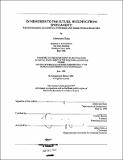In memories to the future, building from spontaneity : reconsidering occidental theories and third world realities
Author(s)
Reza, Ahmereen
DownloadFull printable version (28.78Mb)
Other Contributors
Massachusetts Institute of Technology. Department of Architecture.
Advisor
Nabeel Hamdi.
Terms of use
Metadata
Show full item recordAbstract
Can we use single occidental methods and theory in the act of "place making" in the Third World? The act of "place making" is an important phenomena, particularly in creating a sense of continuity in the transformation of a built environment. It is an interactive layering of events and activities in the development of a place. This thesis is an exploration in reconsidering the application and interpretation of occidental theories which arc inadequate and inappropriate to the realities of the Third World. This is demonstrated by the misinterpretation of scientific methods and history which are used towards a single problem solving exercises . The purpose of this thesis is to raise questions on the intentions behind these occidental methods and their interpretation by others. The first two sections analyze the precedents to the application of occidental methods. The final reflective section is an exploration of spontaneous settlements demonstrating the interactive process used towards "place making". The first chapter explores colonialism as a precedent to applying occidental methods in third world cities. Consequently, these inherited standards, theories and methods to the built environment frequently, demonstrate inappropriate control and classes segregation. The Second chapter reconsiders the myth of present occidental theories, methods and inquiries towards "place making", it explores their intentions, application and misinterpretation. These theories and analysis are inadequate and inappropriate to the realities of the third world as they frequently do not consider the multiplicity of contextual factors, some induced from place, others generated outside of a place. Consequently, a place is frequently a product of a single event which is interpreted as models for replication or are manipulate to benefit the power elite. The Third chapter explores 'learning from spontaneity' and is directed particularly to spontaneous settlements in the third world. This exploration demonstrates the interactive 'cross sectional universe' which impact the built environment. This universe considers place making as a dynamic layering of events and activities through our interpretation of history, economics, politics, society, class, empirical data, market and international forces. It reveals the systemic evolution of space developed according to implicit rules firmly bound to their history, a market exchange society, and the prevalent cultural values, thus recalling explicit memories to the future.
Description
Thesis (M.S.)--Massachusetts Institute of Technology, Dept. of Architecture, 1989. Includes bibliographical references (p. 139-149).
Date issued
1989Department
Massachusetts Institute of Technology. Department of ArchitecturePublisher
Massachusetts Institute of Technology
Keywords
Architecture.